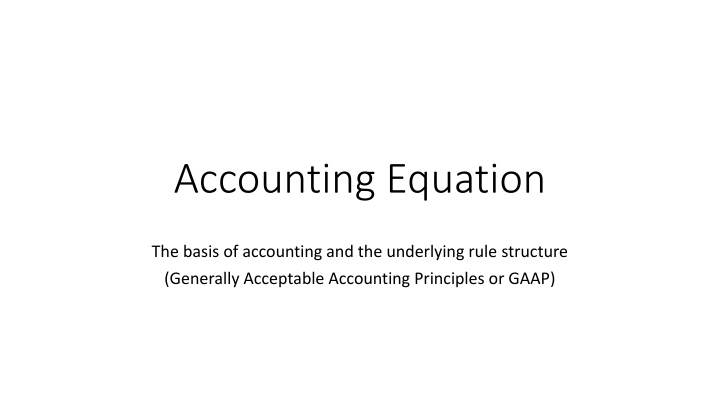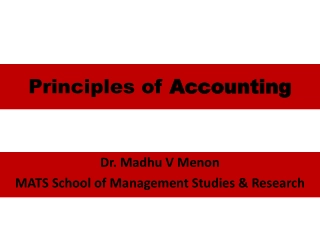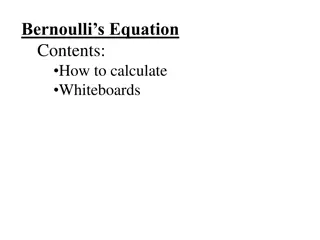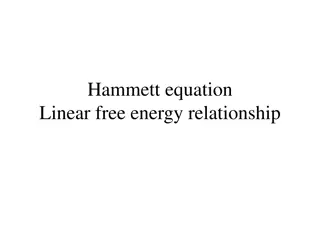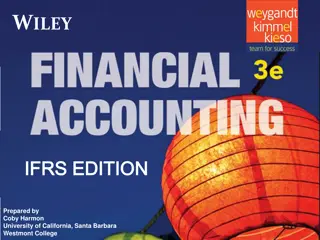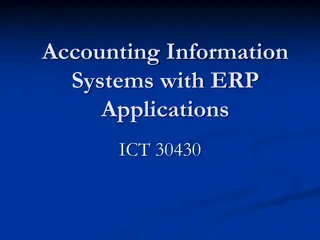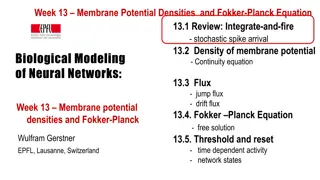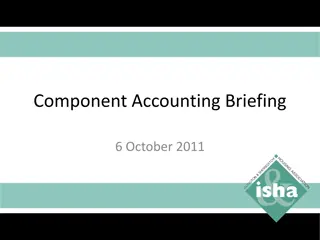Accounting Equation
Accounting is an information system that identifies, records, and communicates business activities. Generally Accepted Accounting Principles (GAAP) provide the rule structure for reliable and comparable financial information. Learn about the SEC's oversight of GAAP, the importance of relevance, reliability, and comparability in financial reporting, and the principles, assumptions, and constraints that guide accounting practices.
Download Presentation

Please find below an Image/Link to download the presentation.
The content on the website is provided AS IS for your information and personal use only. It may not be sold, licensed, or shared on other websites without obtaining consent from the author.If you encounter any issues during the download, it is possible that the publisher has removed the file from their server.
You are allowed to download the files provided on this website for personal or commercial use, subject to the condition that they are used lawfully. All files are the property of their respective owners.
The content on the website is provided AS IS for your information and personal use only. It may not be sold, licensed, or shared on other websites without obtaining consent from the author.
E N D
Presentation Transcript
Accounting Equation The basis of accounting and the underlying rule structure (Generally Acceptable Accounting Principles or GAAP)
Introduction to Accounting Introduction to Accounting Accounting is an information and measurement system that identifies, records, and communicates relevant, reliable, and comparable information about an organization s business activities. Identifying accounting information entails observing transactions and activities within a business and determining if an event requires recording. Recording encompasses generating records related to observations such as journal entries, general ledgers, and trial balances. Communicating entails preparing, presenting and analyzing results and reports such as financial statements which are used internally by the company and externally by the public.
Generally Accepted Accounting Principles Generally Accepted Accounting Principles Financial accounting is governed by concepts and rules known as generally accepted accounting principles (GAAP). GAAP aims to make information relevant, reliable, and comparable to produce faithful representation that accurately reflects business results. Relevant information affects decisions of users. Generally, if the dollar amount is low and will not affect decision makes of external users, the information is not considered to be relevant. The exception is risk. Risk is important to communicate even if the dollar amounts are low (at present). Reliable information is trusted by users. Comparable information aids in contrasting organizations if the entities follow GAAP. Therefore, most companies follow GAAP.
Who governs GAAP? All publicly traded companies are regulated by the Securities and Exchange Commission (SEC). The SEC is a US government agency which oversees the proper use of GAAP. However, this entity has given the preparation of GAAP to the Financial Accounting Standards Board (FASB). Even non-public companies use GAAP for comparability sake and to compete for pools of money (loans). An audit determines if GAAP has been followed.
Conceptual Framework Conceptual Framework Objectives to provide information useful to investors, creditors, and others. Qualitative characteristics to require information that has relevance and faithful representation. Elements to define items in financial statements. Recognition and measurement to set criteria for an item to be recognized as an element; and how to measure it.
Principles, Principles, Assumptions, and Assumptions, and Constraint Constraint There are two types of accounting principles (and assumptions). General principles are the assumptions, concepts, and guidelines for preparing financial statements. Chapters 1, 2, 3, and 12 Specific principles are detailed rules used in reporting business transactions and events. Chapters 4, 5, 6, 7, 8, and 11.
Accounting Principles Accounting Principles There are four general principles. Measurement principle (cost principle) Accounting information is based on actual cost. Cost is measured on a cash or equal-to-cash basis. This means if cash is given for a service, its cost is measured by the cash paid. Exchange values are important but that is for an more advanced class. Information based on cost is considered objective. Objectivity means that information is supported by independent, unbiased evidence. Revenue recognition principle MOST IMPORTANT PRINCIPLE TO UNDERSTAND Revenue is recognized (1) when goods or services are provided to customers and (2) at the amount expected to be received from the customer. Not when the company has been paid. Revenue (sales) is the amount received from selling products and services. The amount received is usually in cash, but it also can be a customer s promise to pay at a future date, called credit sales or accounts receivable. (To recognize means to record it.) Expense recognition principle (matching principle) ANOTHER IMPORTANT PRINCIPLE A company records the expenses it incurred to generate the revenue. Companies incur expenses to generate revenue; these expenses must be matched to the revenue. Full disclosure principle A company reports the details behind financial statements that would impact users decisions. Those disclosures are often in footnotes to the statements.
Accounting Assumptions Accounting Assumptions There are four accounting assumptions. Going-concern assumption Unless otherwise stated, a business is assumed to be a going concern (will continue into the future). If not, the financial statements are noted to be costs at liquidation value. Accounting information presumes that the business will continue operating instead of being closed or sold. Monetary unit assumption Transactions and events are expressed in monetary, or money, units. Examples of monetary units are the U.S. dollar and the Mexican peso. Time period assumption IMPORTANT ASSSUMPTION in Ch 3 The life of a company can be divided into time periods, such as months and years, and useful reports can be prepared for those periods. Companies must record entries as of a specific date (usually the end of the month) and bring all records up to date to this date. And Business entity assumption A business is accounted for separately from other business entities and its owner.
Accounting Constraint Accounting Constraint Cost-benefit constraint, or cost constraint Information disclosed by an entity must have benefits to the user that are greater than the costs of providing it. (Relevance) Example: Companies are not required to spend thousands to ensure amounts lower than a hundred are recorded accurately. Other Constraints: Materiality, or the ability of information to influence decisions, is a constraint. (Relevance) Conservatism Accounting tends to be conservative undervalue assets and overvalue liabilities. Industry practices. Accounting in an industry will follow the same practices.
We will cover corporations this semester but your accounting project in Perdisco is based on a sole proprietorship to provide exposure to this type of entity.
The Basic Accounting Equation The Basic Accounting Equation Assets Represent resources a company has that will provide future services or benefits, i.e. usually more than a month or so. If a company prepays its insurance every six months, it has an asset. If a company pays for its insurance every month, it has incurred an expense. They are many different types of assets, such as cash, accounts receivable, supplies, equipment, etc. There are various specific GAAP rules associated with the accounting treatment for each. When someone owes the company money for services rendered, the asset is called an accounts receivable. The transaction is said to be done on account. Assets are listed in order of liquidity. Liabilities Represent what a company owes. The obligations can be short term such as accounts payable or salaries payable or long- term such as a lease or a loan. When the company owes money to another party (vendor) on a short-term basis for the purchase of supplies, it is called accounts payable. The transaction is said to be done on account. When someone owes the company money (customer) on a short-term basis, it is an asset called accounts receivable. All of those to whom a company owes money are its creditors. These come first in the accounting equation, because they must be paid first before the owners (equity) can receive anything if a company is in liquidation. Shareholder or Owner s Equity Represents accumulation of shareholders wealth. There are two (2) standard shareholders equity accounts Common stock and Retained Earnings. Retained earnings have three (3) basic sub accounts revenue/sales, expenses, and dividends. Time Period Assumption. Important to remember for Chapter 3. Sales of common stock represent infusions of cash to the company increase shareholder/owner s equity. Retained earnings are comprised of all earnings since the company s inception that have been retained and not paid as dividends. Earnings encompass revenue/sales from operations minus expenses. Revenue/Sales increase owner s equity; whereas expenses decrease owner s equity. Dividends are paid out of retained earnings.
Expanded Accounting Expanded Accounting Equation and Financial Equation and Financial Statements Statements Balance Sheet Balance Sheet = + Assets Liabilities Stockholder's Equity Balance Sheet Cash Accounts Payable Common Stock Balance Sheet There are four financial statements and they are prepared in a specific order. Accounts Receivable Ending Retained Earnings Balance Sheet and Stmt of Retained Earnings Income Statement Statement of income and expenses from company operations which yields either net income or a net loss. Net income/loss is then recorded in the Statement of Retained Earnings. Income and Expenses only found on Income Statement. Supplies Equipment Beginning Retained Earnings Statement of Retained Earnings Starts with beginning retained earnings and then adds net income from the income statement minus dividends, yielding the ending balance in retained earnings which flows to the Balance Sheet. Dividends only found on the Stmt of RE. Ending RE is the only account on two financial statements. Plus Net Income Minus Dividends Stmt of Retained Earnings Ending Retained Earnings Balance Sheet and Stmt of Retained Earnings Balance Sheet Listing of Assets, Liabilities, Common Stock and the ending balance of Retained Earnings. Assets, Liabilities, Common Stock, and Ending Retained Earnings only found on Balance Sheet. Revenue Income Statement Minus Expenses Income Statement Statement of Cash Flows How cash was obtained and spent Chapter 12 Net Income
How Do Accounting Transactions Affect the Accounting Equation? Have Balance Sheet Balance Sheet = Owe + Own Asset = Liabilities + Equity Acct Amt Acct Amt Acct Amt Financial Stmt 1 Owner invests $30,000 in corporation Cash 30,000 Common Stock 30,000 Balance Sheet 2 Purchase of supplies $2,500 - future benefits 3 Purchase equipment $26,000 for cash 4 Purchase supplies $7,100 on credit 5 Provide services for cash $4,200 6 Pay rent $1,000 7 Pay salaries $700 8 Provides consulting services $1,600 and rents space $300. Both on account 9 Received cash $1,900 on Accounts Receivable 10 Payment $900 on Accounts Payable 11 Dividends $200 paid
Income Statement Balance Sheet Balance Sheet Consulting Rev Rent Rev Expenses Rent Exp Salary Exp Net Income Have = Owe + Own Asset = Liabilities + Equity Acct Amt Acct Amt Acct Amt Financial Stmt - Statement of Retained Earnings Beginning RE Net Income Subtotal Dividends Ending RE - - - Balance Sheet Assets Cash Accounts Receivable Supplies Equipment Total Assets - Liabilities Accounts Payable Owner's Equity Common Stock Retained Earnings Total Liab and OE - -
Balance Sheet Balance Sheet Income Statement = = + Have Owe Own Liabilities + Asset Equity Revenue Acct Amount Acct Amount Acct Amount Financial Stmt Expenses Rent Exp Salary Exp Net Income 1 Owner invests cash $3,000 and equipment $15,000 in business 2 Purchased furniture $600 Statement of Retained Earnings Beginning RE Net Income Subtotal Dividends 3 Paid facility rent $500 4 Purchased equipment $1,200 on account Ending RE 5 Services rendered for cash $825 Balance Sheet Assets 6 Services rendered on account $100 Cash Furniture Equipment Total Assets 7 Cash recived ($100) for services on account 8 Paid assistant's salary $125 Liabilities Accounts Payable 9 Services rendered for cash $930 Owner's Equity 10 Paid on equipment charged on account $400 Common Stock RE Total Stockholder's Equity 11 Dividends paid $900 Total Liab and OE
Discussion Questions Name three businesses that offer services and three that offer products. Name one business that does both What do accountants mean by objectivity? Describe the revenue recognition principle
